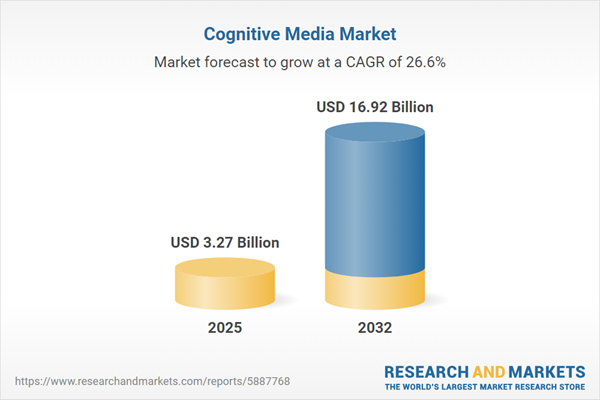Speak directly to the analyst to clarify any post sales queries you may have.
The cognitive media market is rapidly transforming content creation, delivery, and engagement through artificial intelligence innovation. This report guides executives in navigating a complex, evolving landscape by evaluating the sector’s growth drivers, regulatory impacts, segmentation insights, and actionable strategies for leadership.
Market Snapshot: Cognitive Media Market Size and Growth
The Cognitive Media Market grew from USD 2.57 billion in 2024 to USD 3.27 billion in 2025. It is projected to achieve a CAGR of 26.55%, reaching USD 16.92 billion by 2032.
Scope & Segmentation: Strategic Coverage Across the Cognitive Media Market
- Technology: Includes artificial intelligence in general and narrow AI, computer vision with image recognition and video analysis, machine learning incorporating reinforcement, supervised, and unsupervised learning, as well as natural language processing across chatbots, language translation, and sentiment analysis.
- Application: Targets areas such as advertising, content recommendation, customer engagement, and social media analysis, including community management, influencer analysis, and trend analysis.
- Deployment: Encompasses cloud, hybrid, and on-premises setups to address varied data sovereignty and operational priorities.
- End User: Spans education, large enterprises, government, healthcare, and small and medium enterprises seeking intelligent automation and analytical edge.
- Geography: Analyzes opportunities and challenges across Americas (United States, Canada, Mexico, Brazil, others), Europe, Middle East & Africa (United Kingdom, Germany, UAE, South Africa, among others), and Asia-Pacific (China, India, Japan, Southeast Asia, Australia, and more).
- Leading Organizations: Profiles companies such as Amazon.com, Inc., Microsoft Corporation, Alphabet Inc., International Business Machines Corporation, Meta Platforms, Inc., NVIDIA Corporation, Baidu, Inc., Tencent Holdings Limited, Adobe Inc., and C3.ai, Inc.
Key Takeaways for Decision-Makers
- Cognitive media technologies are redefining digital content through real-time personalization, predictive analytics, and AI-driven automation, fundamentally altering how brands engage audiences.
- Regulatory frameworks and heightened privacy standards are promoting ethical AI adoption and responsible data governance across global markets.
- Cloud-native and edge computing are reducing latency and unlocking scalable, low-cost deployments, enabling fluid audience interaction and operational resilience.
- Strategic alliances and open collaboration are accelerating time-to-market for enterprise AI solutions, while niche innovators address targeted application areas.
- Segment-specific adoption reveals new opportunities for education, government, and healthcare, beyond traditional enterprise use cases, supporting differentiated value propositions.
Tariff Impact: Navigating United States Tariffs in 2025
- Tariffs on advanced AI hardware and semiconductor components drive up procurement costs and complicate international supply chains.
- Market participants respond through supply chain diversification, regional manufacturing, and investment in efficient, edge-optimized AI architectures.
- This environment favors organizations with resilient sourcing strategies and established partnerships, heightening barriers for smaller innovators.
Methodology & Data Sources
This analysis employs a rigorous methodology, integrating primary interviews with C-suite executives, technology architects, and domain experts, along with extensive secondary research from scholarly, regulatory, and industry sources. Data triangulation and expert panel reviews ensure robust and reliable market insights.
Why This Report Matters
- Enables senior decision-makers to benchmark key industry shifts, regulatory risks, and opportunities for AI-driven innovation in cognitive media.
- Provides actionable segmentation analysis, identifying growth avenues by technology, application, end user, and region for targeted strategic planning.
- Equips stakeholders to respond to supply chain threats and regulatory change by outlining practical approaches for cost, compliance, and innovation leadership.
Conclusion
As adoption accelerates, cognitive media is reshaping digital business models and audience experiences across sectors. This report provides the insight, segmentation, and strategy to position leaders for success in an advancing technological landscape.
Additional Product Information:
- Purchase of this report includes 1 year online access with quarterly updates.
- This report can be updated on request. Please contact our Customer Experience team using the Ask a Question widget on our website.
Table of Contents
3. Executive Summary
4. Market Overview
7. Cumulative Impact of Artificial Intelligence 2025
Companies Mentioned
The companies profiled in this Cognitive Media market report include:- Amazon.com, Inc.
- Microsoft Corporation
- Alphabet Inc.
- International Business Machines Corporation
- Meta Platforms, Inc.
- NVIDIA Corporation
- Baidu, Inc.
- Tencent Holdings Limited
- Adobe Inc.
- C3.ai, Inc.
Table Information
| Report Attribute | Details |
|---|---|
| No. of Pages | 189 |
| Published | November 2025 |
| Forecast Period | 2025 - 2032 |
| Estimated Market Value ( USD | $ 3.27 Billion |
| Forecasted Market Value ( USD | $ 16.92 Billion |
| Compound Annual Growth Rate | 26.5% |
| Regions Covered | Global |
| No. of Companies Mentioned | 11 |









